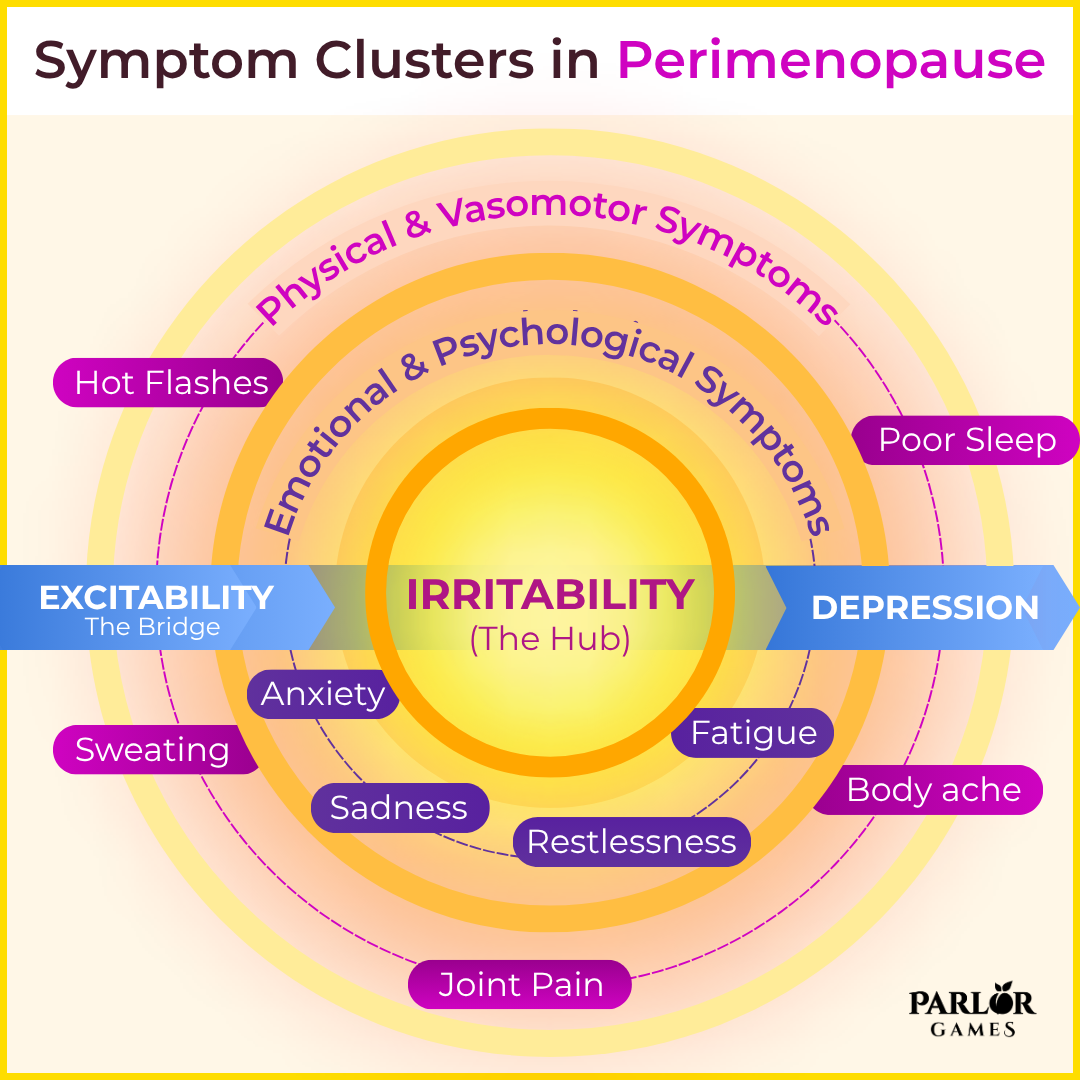LAST DAY TO SAVE 10%* - Coupon BFCM2024
*Excludes BioNude, subscriptions, hormone tests and health coaching

This study examined which perimenopausal symptoms are most influential in driving other symptoms — and which ones act as “bridges” between emotional, physical, and psychological symptom groups.
Instead of treating each symptom separately (like sleep changes, mood swings, or hot flashes), the authors used network analysis, a method that evaluates how symptoms interact and reinforce each other.
They also tested the stability and accuracy of the network to ensure findings were reliable.
⭐ Irritability
This symptom had the strongest connections to others — meaning if irritability flares, many other symptoms tend to worsen. It was the most central node in the network.
⭐ Excitability
This symptom linked anxiety and depressive symptom clusters.
Translation: feeling edgy or over-stimulated may be the domino that triggers anxiety and depressive symptoms.
Perimenopausal symptoms don’t act in isolation — they form a network.
Irritability is the “hub,” and excitability acts as the critical messenger between mood systems.
Supporting emotional regulation during perimenopause (via hormone balancing, nervous-system support, lifestyle strategies, therapy, and stress modulation) may meaningfully shrink the whole symptom web, not just single complaints.
The Study: Zhang, T., Wan, Y., & Geng, L. (2024). Unraveling the core and bridge menopausal symptoms of perimenopausal women: a network analysis. Menopause, 10-1097.

Lorem ipsum dolor sit amet, consectetur adipiscing elit.
Lorem ipsum dolor sit amet, consectetur adipiscing elit.
Lorem ipsum dolor sit amet, consectetur adipiscing elit.
Lorem ipsum dolor sit amet, consectetur adipiscing elit.
Disclaimer: The information provided above is intended for educational and informational purposes only. Statements made have not been evaluated by the FDA nor are they intended to treat or diagnose. Any health concerns should be discussed and evaluated by your primary health care provider.
Parlor Games, LLC ● kate@parlor-games.com ● 5304 River Rd N Ste B ● Keizer OR 97303
Disclaimer: The information provided above is intended for educational and informational purposes only. Statements made have not been evaluated by the FDA nor are they intended to treat or diagnose. Any health concerns should be discussed and evaluated by your primary health care provider.
28 Day Challenge Subscription Details

We ship you a 28 day supply of Silky Peach Cream for only $29 (more than 25% off our normal price) when you sign up for Subscribe & Save.
Follow the directions we include in the package and apply Silky Peach cream on your tender bits for 28 days.

Decision Day:
5 days before your subscription rebills, we’ll send you an email reminder with a link. If you decide Silky Peach is nice but not your thing… you can click that link and cancel your subscription without even talking to anyone. No hassle — no questions asked.
If you are like 72% of our Silky Peach customers, you’ll love it and can't imagine life without it. In that case, do nothing, and we’ll welcome you to the Parlor Games family and ship Silky Peach Cream to your door step every month for the same discounted price of $29 — locked in for as long as you remain a subscriber.

Important note about our easy-breezy subscriptions:
We know that some companies make it hard to cancel a subscription — that’s not us. Our mission is to save the world — one vagina at a time! If you decide you don’t need Estriol as an ongoing solution for dryness, incontinence, UTIs and keeping sex fun and comfortable again, we understand. Five days before we ship your next order, you'll receive an email with a link to cancel right there in the message.
No hunting, no searching, we got you. Respect is where it’s at.
FYI – Estriol is beneficial for skin integrity and mucous membranes. It’s great for vaginal atrophy and also amazing for use on the face and neck. Applying a small amount — about 1 pump — can help build the collagen and plump up the cells to reduce wrinkles. Who knew!!
OUR HAPPINESS GUARANTEE
We want you to feel safe and confident trying any of our products. That's why we promise 100% money-back guarantee on the purchase price of the first bottle of any of our products. Balancing hormones DOES take some time, so please try it for 28 days. If after 28 days you are unhappy, or the product just hasn't worked for you, simply contact us and we'll process a refund of your full purchase price upon receipt. Sorry, shipping fees are not refundable.